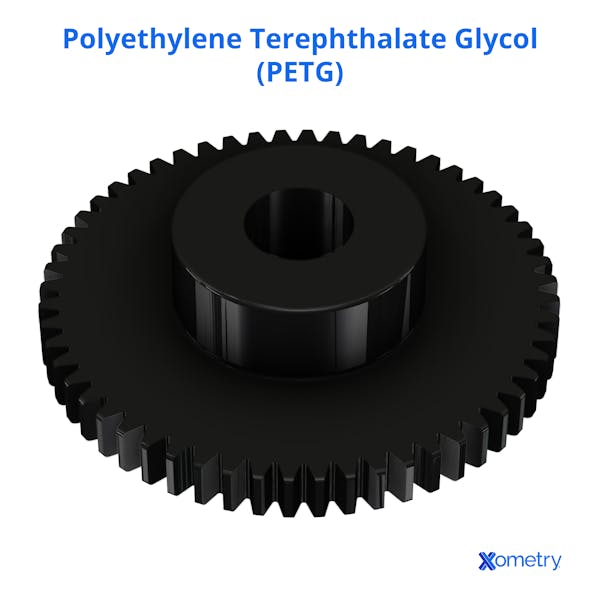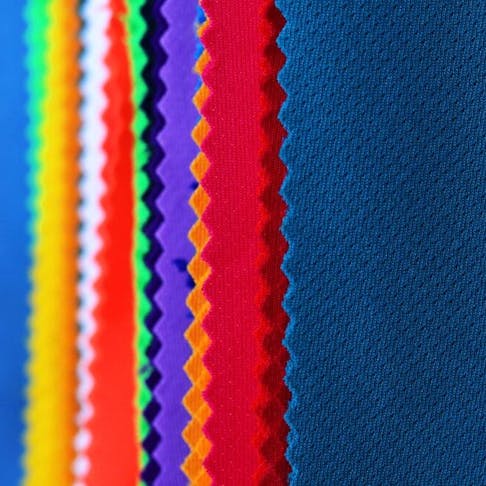Polyester is the third most widely used commodity plastic. It is used extensively for clothing, food packaging, and automotive components. Polyester is characterized by excellent mechanical strength, chemical resistance, wear resistance, and electrical insulating properties. It has a melting point of 246 °C. Polyester is made up of terephthalic acid and ethane-1,2-diol.
Polyester can be processed into fibers using extrusion but can also be injection molded to produce parts with an exceptional surface finish.
This article will discuss what polyester is, who invented polyester, as well as its advantages, disadvantages, and common uses.
What Is Polyester?
Polyester is a very durable plastic that is most commonly used in fiber form for clothing. It is the third most widely used commodity plastic. Polyester is a long-chain polymer composed primarily of ester functional groups and terephthalic acid.
A common trade name for polyester is Terylene. Polyester is further categorized by its chemical makeup as described below:
- PET (Polyethylene Terephthalate): This is the most commonly used grade of polyester and is known by the following trade names: Mylar®, Rynite®, and Impet®.
- PBT (Polybutylene Terephthalate): PBT has a lower melting temperature when compared to PET. It has improved chain flexibility.
- PEN (Polyethylene Naphthalate): PEN has low oxygen permeability. It is used in packaging applications where the product is particularly sensitive to oxidation.
- PTT (Polytrimethylene Terephthalate): This grade is commonly used in the textiles industry due to its stain resistance and durability.
How Polyester is Made?
Polyester plastic is made by combining two monomers, namely a dicarboxylic acid with a diol. More specifically, PET is a condensation polymer that is manufactured by combining terephthalic acid with ethane-1,2-diol. The product of this reaction is polyester and water. The polyester is then either processed into fibers for fabrics or pellets for use in injection- or blow-molding applications.
When was Polyester Invented?
Polyester was invented in the mid-1930s by W.H. Carothers along with his team while working at DuPont. However, this work was not further developed until 1941 when it was expanded upon and patented by a group of British scientists who created the first polyester fiber. DuPont ultimately purchased the rights to the patent and sold it under the brand names: Dacron and, later, Mylar.
How is Polyester Used in Plastic Injection Molding?
Polyester is widely used in injection-molding applications and can be processed like any other injection-moldable thermoplastic. Standard PET, PETG, and PBT are all easily injection molded and produce an excellent surface finish. Polyester resins readily accept minerals and glass reinforcing fillers which are used to improve the overall mechanical performance of injection-molded polyesters.

| Property | Value |
|---|---|
Property Density (g/cm3) | Value 1.33 |
Property Hardness (Shore D) | Value 81.2 |
Property Ultimate Tensile Strength (MPa) | Value 49.2 |
Property Yield Strength (MPa) | Value 61.8 |
Property Elongation @ Break (%) | Value 82.9 |
Property Flexural Yield Strength (MPa) | Value 82.1 |
Property Melting Point (°C) | Value 246 |
Property Heat Deflection Temperature @ 0.46 MPa (°C) | Value 90.8 |
Property Heat Deflection Temperature @ 0.8 MPa (°C) | Value 72.3 |
Property Flammability (UL94) | Value HB-V-0 |
Table 1: Key Physical Properties of PET
What are the Uses of Polyester?
Polyester is widely used in the textile industry, and also in injection-molding applications and can be processed like any other injection-moldable thermoplastic. Standard PET, PETG, and PBT are all easily injection molded and produce an excellent surface finish. Polyester resins readily accept minerals and glass reinforcing fillers which are used to improve the overall mechanical performance of injection-molded polyesters. Examples of its applications are listed below:
- Fibers: Polyester material has high strength and is used in clothing and conveyor belt/car tire reinforcing fabrics.
- Automotive Components: Alternator housings, structural automotive parts, and fog lamps are some common examples of how polyester is utilized for automotive applications.
- Electrical: Circuit breakers can be manufactured from PBT due to the material's dimensional stability and low moisture absorption. Polyester can also be used for insulation tape and electrical cable insulation.
- Medical: Polyester is used to create blister packs for packaging medications.
For more information, see our guide on the Uses of Polyester.
What are the Advantages of Polyester?
Polyester is a widely used polymer due to its durability and strength, especially when produced in the form of fabrics or films. Polyester is also hydrophobic, meaning that it doesn't readily absorb water, making it ideal for clothing. Polyester is resistant to a wide range of chemicals but can be damaged by solvents like trichloromethane with a mixture of phenol as well as by strong alkalies. Polyester is a low-cost commodity plastic when compared to nylon, for example. In addition to its chemical resistance, polyester is an electrical insulator and has good wear resistance.
What are the Disadvantages of Polyester?
Despite its many uses and advantages, polyester does have some drawbacks, such as having a very polluting production process. For every 1 kg of polyester produced, 14.2 kg of CO2 is produced. Polyester has a high ignition temperature but nonetheless can melt easily. When exposed to an open flame, this molten plastic can cause serious injuries. Despite being an electrical insulator, polyester can build up a static charge and as such can damage sensitive electronics.
Common FAQs About Polyester
How Does Polyester Affect Human Health?
Polyester fabric is a widely used material for consumer clothing and as such comes into direct contact with the skin. Polyester can cause some skin irritation to persons with sensitive skin but is not defined as a material that produces allergic contact dermatitis. Polyester cannot be inhaled and only processing fumes developed during melt processing can irritate the nose and throat.
Is Polyester Toxic?
Polyester is not classified as toxic in its usual forms. Processing fumes and combustion products can be harmful and even toxic, however. In processed form, polyester is nontoxic.
Is Polyester Plastic?
Polyester is a plastic and is the third most widely used commodity plastic. More specifically, polyester is a thermoplastic that is processed by melting it in pellet form and extruding it into fibers or injecting it into molds using standard melt processing techniques.
Summary
This article provided a summary of polyester's properties, applications, advantages, types, and toxicity.
Xometry offers injection molding services for all of your prototyping and production needs. Visit our website to learn more about our manufacturing capabilities and to request a free, no-obligation quote using our Instant Quote Engine.
Copyright and Trademark Notices
- Mylar® is a registered trademark of DuPont Teijin Films, Chester, VA.
- Rynite® is a registered trademark of E.I. Du Pont De Nemours and Company, Wilmington, DE.
- Impet® is a registered trademark of CNA Holdings LLC, Irving, TX.
- Dacron® is a registered trademark of E.I. Du Pont De Nemours and Company, Wilmington, DE.
Disclaimer
The content appearing on this webpage is for informational purposes only. Xometry makes no representation or warranty of any kind, be it expressed or implied, as to the accuracy, completeness, or validity of the information. Any performance parameters, geometric tolerances, specific design features, quality and types of materials, or processes should not be inferred to represent what will be delivered by third-party suppliers or manufacturers through Xometry’s network. Buyers seeking quotes for parts are responsible for defining the specific requirements for those parts. Please refer to our terms and conditions for more information.

